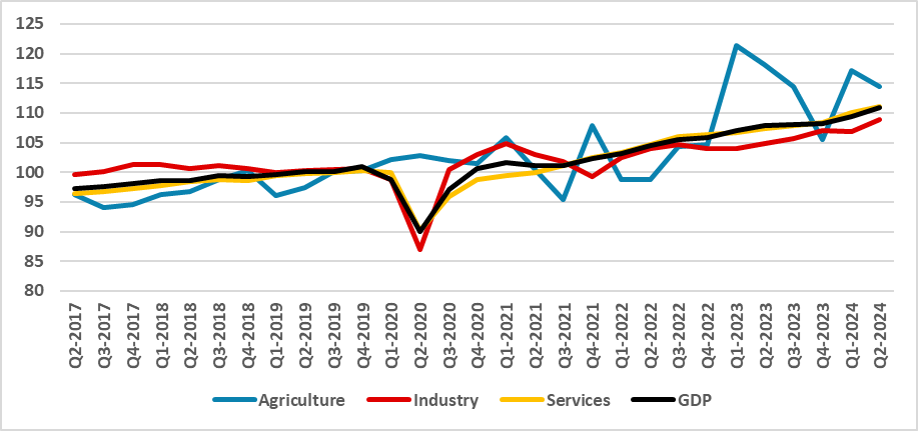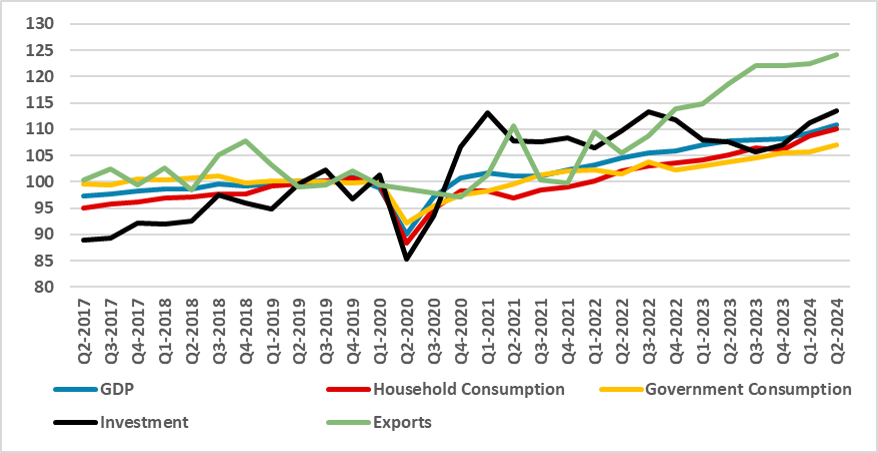Brazil: GDP Surprises in Q2, Growing 1.4% (q/q)
Brazil's Q2 GDP grew 1.4% (q/q), surpassing expectations, driven by strong industrial growth and robust internal demand. Investment increased by 2.1%, while external demand lagged due to rising imports. Agriculture declined due to floods, but services grew steadily. With internal demand as the key growth driver, the economy is forecasted to grow 2.6% in 2024, though the sustainability of this growth without fiscal support remains uncertain.
Figure 1: Brazil GDP by Sectors (2019=100, Seasonally Adjusted)

Source: IBGE
The Brazilian National Statistics Institute (IBGE) has released the GDP figures for Q2. The data surpassed market expectations—0.9% quarter-over-quarter (q/q) according to Bloomberg—and grew 1.4% (q/q) during the quarter. The biggest surprise clearly came from the industrial sector, which grew 1.8% (q/q), driven by a recovery in manufacturing (+1.8% q/q), a surge in utilities (+4.2% q/q), and construction (+3.5% q/q). This more than compensated for the decline in mining (-4.4% q/q). Agriculture dropped 2.3% in the quarter, influenced by floods in the southern region of the country. The services sector also showed robust growth (+1% q/q), with all its subcomponents registering positive growth, especially trade (+1.4% q/q), finance (+2% q/q), and IT activities (+1.7% q/q). Compared to the same quarter of 2023, the Brazilian economy grew 3.3%.
Figure 2: Brazil GDP by Demand (2019=100, Seasonally Adjusted)

Source: IBGE
From the demand perspective, internal demand led the growth, with both household and government consumption growing above the 1% mark during the quarter. However, the biggest surprise was in investment, which grew 2.1% during the quarter. External demand was a drag on growth as exports grew 1.4% (q/q) while imports grew 7.6% (q/q). This suggests that internal demand is heating up.
With the Q2 figures, we can again confirm that the Brazilian economy has surpassed expectations, but this time the main driver of growth was internal demand, rather than the strong surge in the agricultural sector last year. It seems that the increase in higher social transfers and the economy's idle capacity provided some room for growth. Whether this growth will be sustainable in the absence of a fiscal push remains to be seen.
We are now forecasting the Brazilian economy to grow 2.6% in 2024, close to the 2.9% seen last year, and significantly higher than the 2016-2019 trend (around 1.4%). We still need to evaluate whether this marks a new growth trend or if it is merely a surge driven by fiscal stimulus. For next year, the government will aim to maintain a 0% deficit, which should reduce the fiscal push.